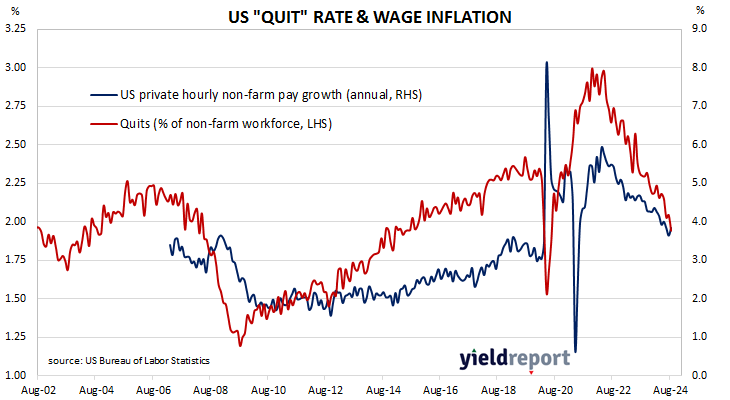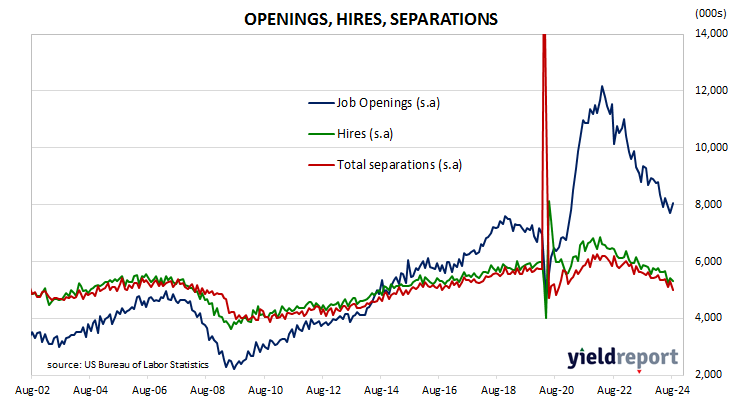Summary: US quit rate ticks down to 1.9% in August; UBS: back to 2015 levels; US Treasury yields fall; expectations of Fed rate cuts soften, seven cuts still priced in; ANZ: US labour market effectively in balance; fewer quits, more openings, fewer separations; ANZ: job vacancies lowest since January 2021.
The number of US employees who quit their jobs as a percentage of total employment increased slowly but steadily after the GFC. It peaked in March 2019 and then tracked sideways until virus containment measures were introduced in March 2020. The quit rate then plummeted as alternative employment opportunities rapidly dried up. Following the easing of US pandemic restrictions, it proceeded to recover back to its pre-pandemic rate in the third quarter of 2020 and trended higher through 2021 before easing through 2022, 2023 and the first half of 2024.
Figures released as part of the latest Job Openings and Labor Turnover Survey (JOLTS) report show the quit rate ticked lower in August after revisions. 1.9% of the non-farm workforce left their jobs voluntarily, down from July’s downwardly-revised rate of 2.0%. Quits in the month decreased by 159,000 while an additional 142,000 people were employed in non-farm sectors.
“Quits continued to trend down and the total quit rate fell another tenth to 1.9%, also a new low for the expansion, and back to 2015 levels,” said UBS economist Amanda Wilcox.
US Treasury bond yields fell almost uniformly across the curve on the day. By the close of business, the 2-year Treasury bond yield had lost 4bps to 3.60% while 10-year and 30-year yields both finished 5bps lower at 3.73% and 4.07% respectively.
In terms of US Fed policy, expectations of a lower federal funds rate in the next 12 months softened, although at least another seven 25bp cuts are still factored in. At the close of business, contracts implied the effective federal funds rate would average 4.525% in November, 4.32% in December and 3.80% in February. September 2025 contracts implied 3.025%, 180bps less than the current rate.
“The JOLTS data point to a labour market effectively in balance,” said ANZ FX analyst Ryan Wells. “The job openings data for the last day of August and the initial claims data for the survey week in September are pointing to a firmer September labour market report than in August.”
The fall in total quits was led by 63,000 fewer resignations in the “Accommodation and food services” sector while the “Professional and business services” sector experienced the largest increase, 73,000. Overall, the total number of quits for the month decreased from July’s revised figure of 3.243 million to 3.084 million.
Total vacancies at the end of August increased by 329,000, or 4.3%, from July’s revised figure of 7.711 million to 8.040 million. The rise was driven by 138,000 more open positions in the “Construction” sector while the “Other services” sector experienced 93,000 fewer offerings, the single largest decrease. Overall, 9 out of 18 sectors experienced more job openings than in the previous month.
Total separations decreased by 317,000, or 6.0%, from July’s revised figure of 5.314 million to 4.997 million. The fall was led by the “Accommodation and food services” sector where there were 111,000 fewer separations while the “Professional and business services” sector experienced 149,000 more separations. Separations decreased in 15 of the 18 sectors.
The “quit” rate time series produced by the JOLTS report is a leading indicator of US hourly pay. As wages account for around 55% of a product’s or service’s price in the US, wage inflation and overall inflation rates tend to be closely related. Former Federal Reserve chief and current Treasury Secretary Janet Yellen was known to pay close attention to it.



